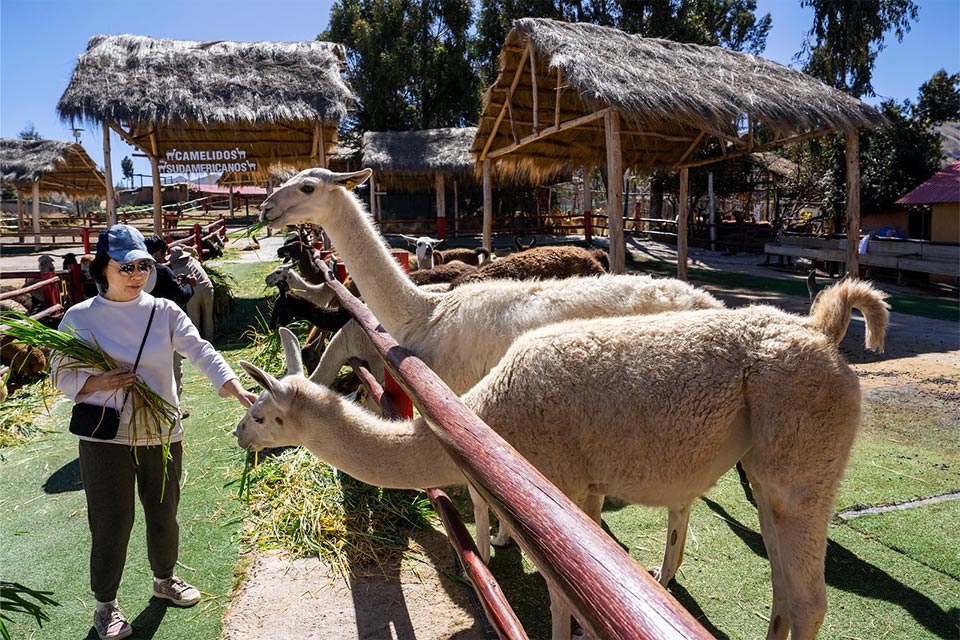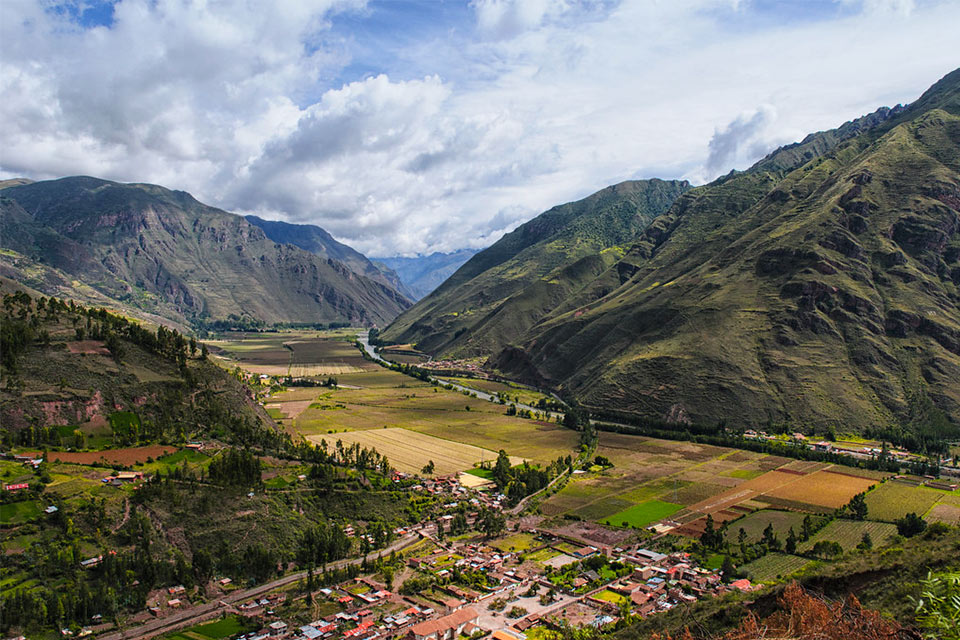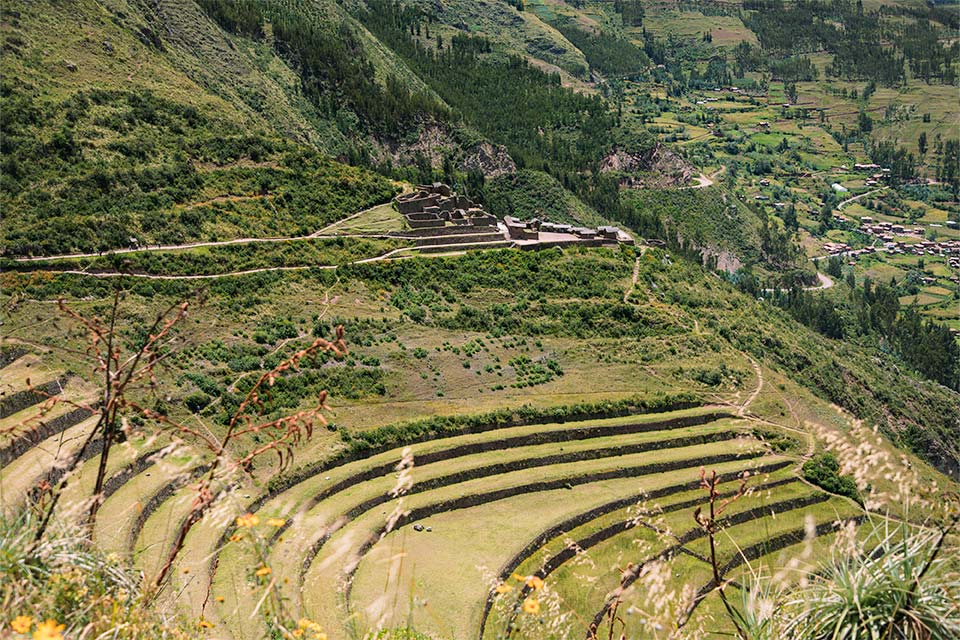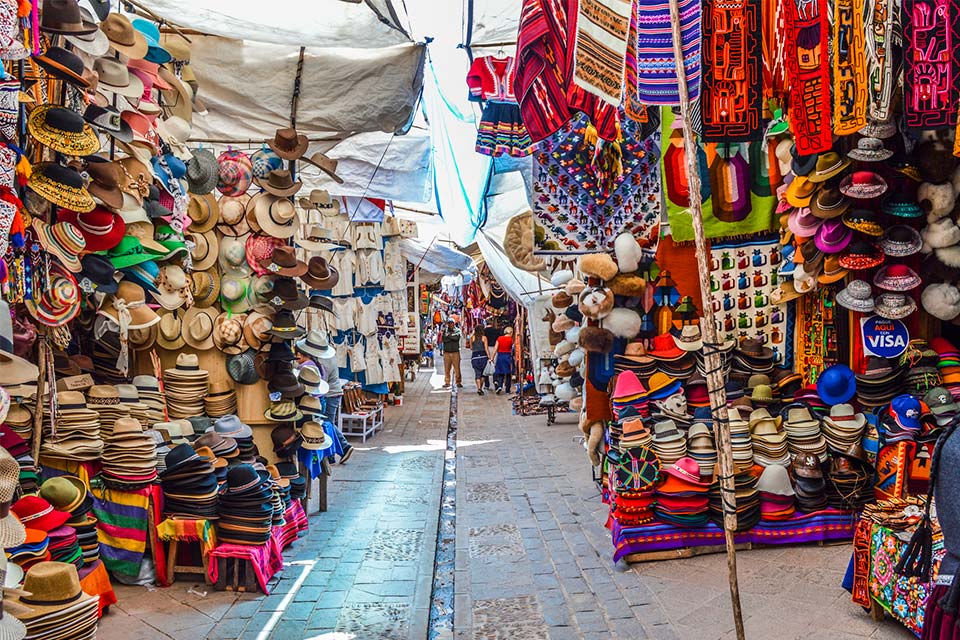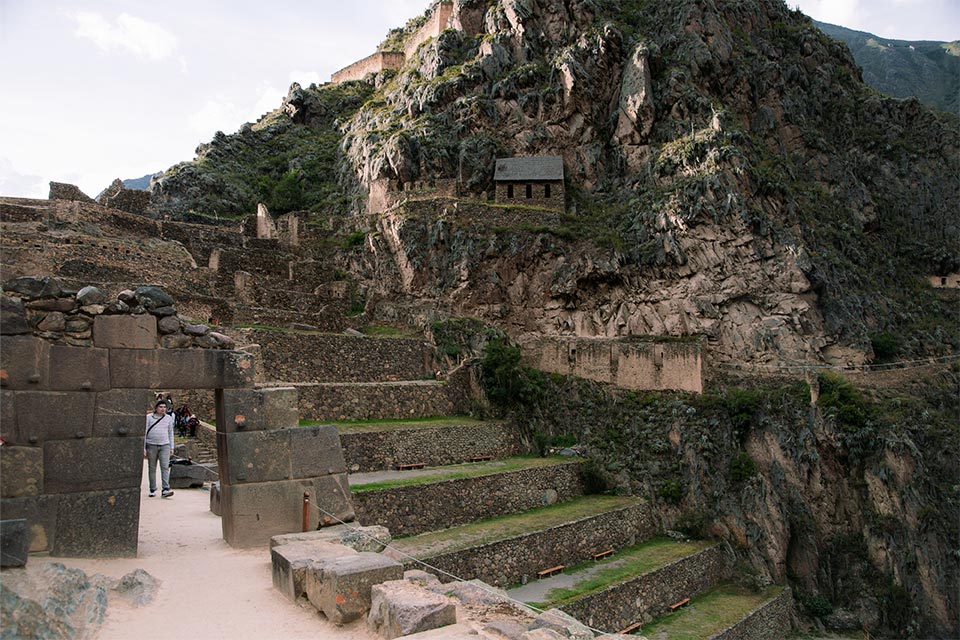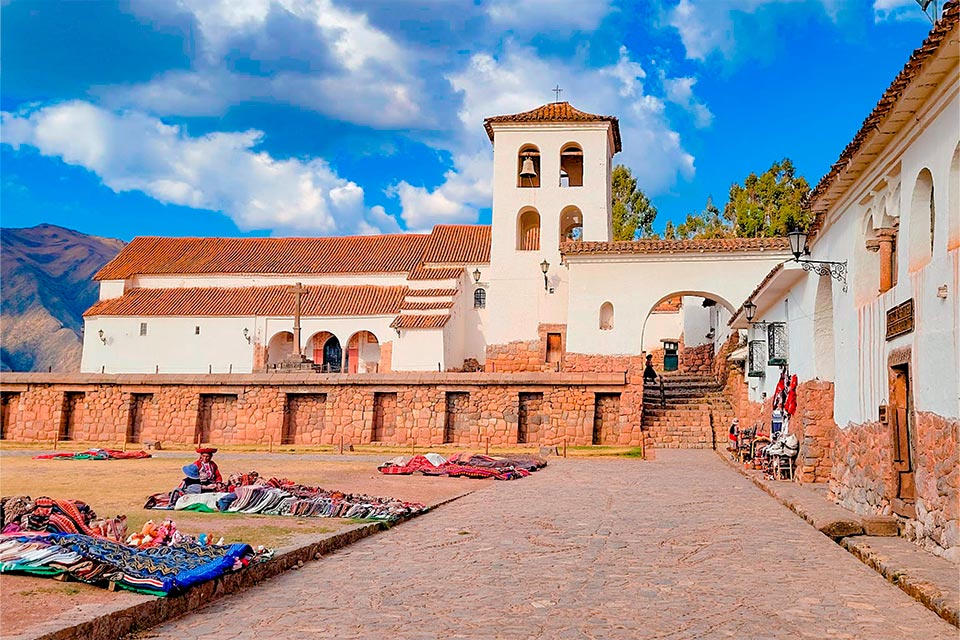If you're in Peru, be sure to join this Sacred Valley Tour Full Day. This region is known for its magnificent landscapes, amazing Inca sites, and local culture, which has been alive for centuries. Starting from Cusco, we’ll go by exclusive group car directly to explore the Sacred Valley’s stunning key spots, such as Pisac, Ollantaytambo, and Chinchero.
This is a small group premium tour, including a Partial Cusco Tourist Ticket III (Entrance fee to Pisac, Ollantaytambo, and Chinchero) and buffet meals at exclusive restaurants. You will spend an unforgettable day discovering everything this place offers, learning about Peruvian history from a guide, tasting incredible food, and shopping at local markets. Book with us now!
Overview of the Sacred Valley tour from Cusco
The Sacred Valley of the Incas offers an amazing journey through some of the Peruvian Andes' most stunning and sacred sites, once inhabited by the Inca civilization. This tour kicks off with an early pick up from your hotel in Cusco and takes you to the fertile lands of the Valley. You will visit the alpaca farm, Taray viewpoint, Pisac Inca site, and the bustling Pisac Market. Plus, you'll enjoy a tasty lunch in a local restaurant in Urubamba.
In the second part, you'll delve into the unique village of Ollantaytambo, renowned for its well-preserved fortress and the scene of epic battles. It's also famous for its original Inca streets, which can still be explored today. To cap it off, you'll immerse yourself in Chinchero Village, where you'll interact with traditional weavers who've perfected their craft with alpaca wool for centuries.
This comprehensive Sacred Valley Tour is perfect for anyone who wants to experience the best of Peru in a single day. So don’t wait any longer; book your spot on the Sacred Valley!
Tour Highlights
- Enjoy an all-inclusive tour with an expert guide, meals, and entry tickets.
- Explore the best spots of the Sacred Valley of the Incas.
- Start the tour from your Cusco center hotel.
- Marvel at local markets and alpaca farms.
- Combine nature, history, and art in a full day experience.
Cusco Sacred Valley Tour 1 day at a glance
- 8:00 am. Pick up from your hotel in Cusco center: Our exclusive transportation for the group will pick you up from your Cusco hotel lobby. Be ready there at the appointed time!
- 8:45 am. Alpaca farm: Visit an Andean alpaca farm; learn about camelids and native fibers.
- 9:00 am. Taray viewpoint stop for wide valley views and quick photos.
- 9:45 am. Pisac Ruins: Guided walk through Pisac Archaeological Site: terraces and temples.
- 10:30 am. Pisac market: Browse crafts and handicrafts at the Pisac market.
- 12:00 pm. Lunch in Urubamba: Buffet menu with vegetarian options.
- 1:30 pm. Ollantaytambo: Explore Ollantaytambo fortress and town with your guide.
- 3:30 pm. Chinchero Ruins: Discover the Chinchero ruins and the historic plaza.
- 4:30 pm. Weaving center: Weaving Inca techniques demo: natural dyes, and looms.
- 6:00 pm. Drop-off at your hotel: Return to Cusco and drop-off at your hotel.
Included
- Cusco center hotel pick up and drop-off
- Exclusive transportation for the group
- Professional tour guide
- Buffet lunch at a restaurant in Urubamba with vegetarian options
- Partial Cusco Tourist Ticket III - Entrance fee to Pisac, Ollantaytambo, and Chinchero
Not Included
- Breakfast and dinner
- Snacks
- Personal expenses
- Gratuities
Extra Upgrades and private service
- Maras & Moray: If you want to add Maras & Moray to the fantastic attractions mentioned above, we present our Super Sacred Valley tour with Maras and Moray Full Day.
- Private service: You can upgrade to a private experience with private transportation and a tour guide. When booking through our system, select the "Private Service" option and continue the booking process. For larger groups, contact us for special pricing.
- Vegetarian options: Vegetarian meals are available as part of our wide variety of buffet lunch dishes.
Why book with TreXperience?
- Local Expert: Get the best prices and best service with a 100% Peruvian tour operator company.
- Expert Tour Guides: Our tour guides are professionals and fluent in English.
- TreXperience always has a solution: Contact us, we always have other tour options for you.
- Want more?: We can provide you with a half-day tour of Maras Moray & Chinchero.
Sacred Valley Full Day Tour Itinerary
This Sacred Valley Tour starts at 8:00 am with a pick up from your hotel in Cusco. We will travel through the highlands around Cusco on our way to the Sacred Valley.
The first stop is at an alpaca farm, where you will get to know the famous South American camelids: llamas, alpacas, vicuñas, and guanacos, as well as learn about their differences, importance, and habits. From here, we'll reach Taray viewpoint, an observation platform where you'll witness the Sacred Valley's breathtaking vistas, including the Urubamba River and the farming lands in the Peruvian Andes.
The next stop is at the archaeological site of Pisac, an Inca village built on top of the mountain, of which we will explore its lower part. This extraordinary place boasts a complex of impressive temples, houses, and hundreds of tombs enclosed by gigantic walls. There are also agricultural terraces you can explore.
After visiting the site, we'll make our way to the local town and check out the Pisac handicraft market. This is a popular place for local craftspeople who manufacture their goods and sell them directly to tourists. From here, it'll be just 1 hour to Urubamba, where you'll enjoy a meal at a local restaurant. The restaurant offers a buffet-style meal with several options and fresh ingredients sourced from the area.
After lunch, we'll drive to the lovely village of Ollantaytambo, known as the "Last Living Inca City". The town still has its original Inca streets, which the locals still use today. While exploring the village, you will have the chance to see the well-guarded Inca citadel constructed to defend the Inca people from potential attackers. Ollantaytambo also serves as the gateway to Machu Picchu.
The last place to visit is Chinchero, a royal estate and ceremonial center during the Inca Empire. It is said to have been a favorite of the 10th Inca King, Tupac Inca Yupanqui. During your visit, you will explore an Inca Palace, visit its colonial church, and learn about the local artisans' renowned weaving techniques and natural dyes.
The tour will end in the late afternoon, returning to your hotel in Cusco around 6:00 pm.
Price of the Sacred Valley Peru Day Tour
We operate small-group tours to keep your experience personal and immersive. Traveling with a big party or prefer something exclusive? We also offer a one-day private tour of the Sacred Valley, too. Contact us today, and we’ll share the other best tour options and design the perfect itinerary to fit your dates, pace, and interests.
Price per person
- From US$ 80 per person - Adult
- For 4+ Travelers, contact us to get a special price: info@trexperienceperu.com
Booking and payment
You can pay for the tour through our booking system or at our office in Cusco using a credit card, PayPal, or wire transfer. Contact us for alternative payment options.
Before you book
- This tour can be booked from one day to the next.
- This tour is available every day.
- You'll visit some markets, so bring cash (soles).
How to book
To book this tour:
- Click on the BOOK NOW button, choose your travel date, and select the tour option of your choice (group or private service).
- Fill in all the requested details with your passport data.
- Finally, enter your credit/debit card details and make the payment.
- Our team will contact you shortly to reconfirm your payment and give you more information.
Similar tours you might be interested in
Places we visit in the Sacred Valley
Alpaca farm
It is an Andean farm near Taray dedicated to breeding alpacas, llamas, guanacos, and vicuñas. Visits cover their role in Andean life and the textile process from shearing and spinning to natural dyeing and weaving. Interactive areas show camelid breeds, and you can feed and pet them while guides explain habits. It’s a hands-on stop to see how fiber becomes Andean yarn and textiles.
Taray viewpoint
The viewpoint of Taray offers wide views of the Sacred Valley and the Andes. A short 20–30 minute path rises through fields of corn and quinoa to a hilltop lookout above the Urubamba River. It’s ideal for photos and a quick break to take in the landscape. Nearby lie key Inca sites such as Pisac and Ollantaytambo, making this stop a simple way to link scenery with the region’s past.
Pisac Archaeological Site
Set on a ridge 30 km northeast of Cusco at 3,400 m, Pisac is a large Inca complex of temples, terraces, and burial areas. Its Intihuatana ritual stone crowns the highest sector and likely supported astronomical observation. Vast agricultural terraces shape the slopes, while remains of storehouses, workshops, and quarters show how priests and nobles lived and managed food and ritual life.
Pisac Market
Pisac Market is a daily craft hub, busiest on Sundays when vendors arrive from nearby villages. Stalls display alpaca-wool clothing, hats, scarves, blankets, and textiles with Andean motifs, along with pottery, jewelry, and instruments. You can watch artisans at work and ask about their techniques. There are also snacks and produce, from empanadas and tamales to chicha and fresh fruit.
Ollantaytambo Inca Fortress
Ollantaytambo, 60 km northwest of Cusco (2,792 m), preserves one of the finest Inca sites: a hilltop fortress with massive stone walls, a temple sector, and sweeping agricultural terraces. It was a key stronghold during the Spanish invasion. Today you can explore the ruins, stroll the living Inca-planned town, shop the market, and use the village as a gateway to the Inca Trail.
Town of Chinchero
Chinchero (3,762 m) is famed for weaving. Workshops demonstrate natural dyes from cochineal, indigo, and local plants, and patterns inspired by Andean symbols like the chakana and puma. Artisans use backstrap and pedal looms to create scarves, blankets, and bags, which you can purchase at the market. The surrounding hills show striking color tones, especially after rain.
What to bring for my Sacred Valley of the Incas Full Day Tour
Recommended list for this journey:
- Comfortable walking shoes: The tour involves walking on uneven terrain.
- Hat and sunscreen: Be prepared for a sunny day.
- Camera: You will want to capture stunning views and unique sites.
- Water bottle: It's important to stay hydrated, so bring a refillable water bottle.
- Light jacket or sweater: The weather in Sacred Valley can be unpredictable, so it's a good idea to bring a light jacket or sweater.
- Snacks: While lunch is usually provided on tour, bringing a snack or two is always a good idea to keep you fueled throughout the day.
- Cash or credit card: You may want to purchase souvenirs or snacks during the tour, so bring some cash or a credit card.
- Insect repellent: The Sacred Valley is a natural environment with many insects, so bring insect repellent to protect yourself.
- Small backpack: Bring a small bag to carry your essential items and snacks.
- Portable charger: Bring a portable charger or extra batteries for your camera and phone.
- Rain gear: Have rain ponchos or rain jackets with you all the time.
Note: The tour involves walking on uneven terrain, so it's recommended to bring only essential items and avoid carrying heavy bags or backpacks. Also, the weather in Sacred Valley can be unpredictable, so it's a good idea to check the forecast and pack accordingly
Useful information about the Sacred Valley day tour from Cusco
Find essential travel information, tips, and insider advice to enhance your journey through Incan history and stunning Andean scenery. Ready to create memories that will last a lifetime? Start your adventure here!
Cusco Tourist Ticket
The Cusco Tourist Ticket (Boleto Turístico) It's a single ticket that includes admission to various archaeological sites and museums. It's provided by COSITUC, the Committee on Integrated Cultural Tourism Services of the Municipality of Cusco. It is required to enter most archaeological sites in the Sacred Valley, the city of Cusco, and several museums. This tour already includes the partial ticket that covers the Sacred Valley. But if you plan to visit more places on your own, you can also purchase the full ticket.
Check out what’s included in the Cusco Tourist Ticket.
Cusco Tourist Ticket - Partial III - Sacred Valley of the Incas
This is an entrance fee to Pisac, Ollantaytambo, Moray, and Chinchero
- Peruvians: S/. 40
- Foreigners: S/. 70
Valid from 1 to 2 days
Full ticket – All circuits (Cusco + Sacred Valley + museums)
- Peruvians: S/. 70
- Foreigners: S/. 130
Valid for 10 days
Tips for visiting the Sacred Valley
- Start your visit in Cusco: Cusco is the gateway to the Sacred Valley, and it's a great place to acclimate to the altitude before heading into the valley. Please spend a few days exploring the city and its Inca ruins before heading out.
- Take your time: The Sacred Valley is huge, and there's a lot to see and do. Don't try to pack too much into one trip – take your time and enjoy the valley at a relaxed pace.
- Visit during the off-season: The Sacred Valley is busiest during peak tourist season (June-August), so if you want to avoid the crowds, plan your visit for shoulder season (April-May or September-October).
- Hire a tour company: A local guide can show you around the Sacred Valley and help you make the most of your visit. They can also share insider tips on where and what to see.
- Stay in Ollantaytambo town for 1 night: Several villages are located throughout the Sacred Valley, each with unique charms. Staying in Ollantaytambo before Machu Picchu and the Inca Trail is a perfect choice.
The Sacred Valley of the Incas is a beautiful and historical place in Peru, once the center of the Inca Empire and now a popular tourist destination. The Sacred Valley is home to many ancient ruins, including the famous Machu Picchu, as well as stunning natural scenery. If you plan a trip to Peru, add the Sacred Valley of the Incas to your itinerary!
Location
The Sacred Valley is located in the Andes Mountains of Peru, about 50 kilometers (300 miles) from Cusco. It is a beautiful and fertile valley with many Inca sites. The main towns in the Sacred Valley are Pisac, Calca, Urubamba, and Ollantaytambo. The Urubamba River runs along the Sacred Valley, a tributary of the Amazon River, the world's largest river.
History
Once a core hub of the Inca state, the valley supplied food, hosted ceremonial centers, and connected highland routes. Spanish rule brought towns and churches and displaced communities, yet Andean life ways endured. Today, agriculture, markets, and ruins coexist, showing how the region moved from imperial heartland to a modern travel corridor.
Weather
Days are generally mild (15–25 °C) with cooler mornings and nights, especially at higher spots. The dry season runs from April to October; the wet season November–March, brings frequent showers and greener hillsides. Trails can be muddy after rain, so pack layers, a rain jacket, sun protection, and sturdy shoes. UV is strong year-round at altitude.
Best time to go to Sacred Valley
For clear skies and steady conditions, choose May–September. April and October balance sunshine with lighter crowds, while November–March is rainier but lush and often cheaper. Book early for June festivities and high-demand dates, start visits early to enjoy Pisac and Ollantaytambo with fewer people, and keep a flexible time for traffic or weather.
Altitude
The altitude ranges from 2,700 to 3,400 meters (8,860 to 11,200 ft) above sea level. The valley is one of the most fertile areas in the world and is home to many different crops, such as potatoes, maize, quinoa, and amaranth. The soil is also extremely rich in minerals, which has made it a popular destination for agriculture and mining.
Prevent the Altitude Sickness in the Sacred Valley
Arrive rested, hydrate often, and avoid heavy meals and alcohol on day one. Walk slowly on stairs, take breaks, and use sun protection. Consider spending the first night at lower-lying Urubamba before tackling higher sites. Coca tea can help some travelers; for medication, consult your doctor in advance about options such as acetazolamide.
Sacred Valley and Machu Picchu
The valley is the main gateway to Machu Picchu. Most travelers reach Ollantaytambo by road, then take the train to Aguas Calientes; others start multi-day treks nearby. Tours connect markets, weaving centers, and temples with the rail journey to the citadel, a UNESCO World Heritage Site and one of the New Seven Wonders of the World.
Sacred Valley Tour Frequently Asked Questions
Are you thinking about taking a trip to the Sacred Valley in Peru? If so, you probably have a lot of questions. Fortunately, we've got answers. This page will answer some of the most frequently asked questions about the Sacred Valley tour.
When, during my stay in Cusco, can I take the Sacred Valley tour?
It is advisable to take the Sacred Valley tour after the City Tour, that is, on the third or fourth day after arriving in Cusco. By then, you will have acclimatized and can take the train to Machu Picchu.
What are the different types of tours available?
There are different types of tours available in the Sacred Valley:
You can choose a standard small group tour, which includes a professional guide, transportation, Partial Cusco Tourist Ticket III ( Entrance fee to Pisac, Ollantaytambo, and Chinchero), and lunch in a local restaurant in Urubamba
Private tours, where you can explore the valley at your own pace, and a private tour guide just for your party.
You can also explore the Sacred Valley on a private tour with a Picnic lunch. This service is available upon request and requires a special quote depending on the number of travelers at your party.
What are the age requirements for the Sacred Valley Tour?
The Sacred Valley Tour is suitable for travelers of all ages. Of course, minors with an adult are welcome, too!
Do I need to be at a certain fitness level to participate in a tour?
No, you don't need to be at a certain fitness level to participate in the Sacred Valley Tour. However, we recommend you have a basic fitness level to enjoy the tour. The Sacred Valley Tour is a moderate hike, and we'll be walking for about 30 minutes at each place we visit.
Can I bring my food and drink on tour?
You are welcome to bring your food and drink on tour. However, please be mindful of the following:
All food and drink must be stored in a cool bag or box.
Do not leave any waste in the places we visit
Alcohol is not permitted.
If you have any special dietary requirements, please let us know in advance so that we can accommodate you.
Can I customize the tour?
Yes, you can customize the tour in the private service. You can choose which sites to visit and how long to spend at each location. You can also add optional activities like horseback riding, mountain biking, and picnic meals. The tour guide will work with you to create a custom itinerary that fits your interests and schedule.
Is the tour wheelchair accessible?
Accessibility in the Sacred Valley varies by location. Some sites are accessible, but places like the Maras Salt Mines and Moray terraces can be difficult due to uneven terrain. Don't hesitate to get in touch with us to provide specific accessibility details before you go.
Can the tour finish in Ollantaytambo to catch the train to Aguas Calientes?
Yes, of course. We can drop you off in Ollantaytambo to catch your train to Aguas Calientes. Only valid for trains departing from Ollantaytambo after 4:00 p.m. In this case, you wouldn't be able to visit the final stop, Chinchero.
Does the route include a drop-off at the hotel in the Valley?
No, unfortunately, our group tour does not include this service. However, if you take our private service, it does include!
Are there discounts for children/students?
Unfortunately, there is no student discount available for this tour.
Are there restrooms along the route?
Yes, there are, especially at the Urubamba restaurant, so don't worry.
Are drones, tripods, or flash allowed during this tour?
Drone use is restricted and requires permits; tripods and flash in churches and archaeological parks, too. Always follow on-site rules.

